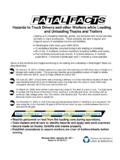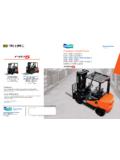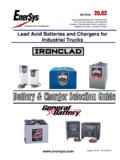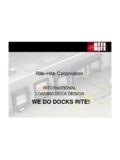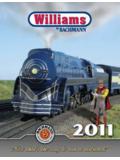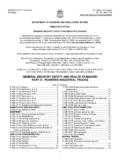Transcription of POWERED INDUSTRIAL TRUCK PROGRAM …
1 SAMPLE WRITTEN PROGRAM FOR POWERED INDUSTRIAL TRUCK PROGRAM (FORKLIFT) 2 POWERED INDUSTRIAL TRUCKS PRGORAM TABLE OF CONTENTS Authority and Reference ..3 Responsibility for Definition of Terms ..4 POWERED INDUSTRIAL Trucks Rules for Safety TRUCK Operations ..6 Travelling ..7 Loading/Stacking ..8 Maintenance of Trucks ..8 Equipment Inspection and Maintenance ..9 Operator Training ..9 PROGRAM Inspection Checklists Appendix A-1: Electric Appendix A-2: Propane Appendix A-3: Yard Forklift ..15 Appendix A-4: Electric Transtacker ..17 Appendix A-5: Riding Grip Tow ..18 Appendix A-6: Stand-up Riding Tow Tractor ..19 AppendixA-7: Walking Pallet TRUCK ..20 Appendix A-8: Walking Transtacker ..21 Appendix A-9: INDUSTRIAL Propane Tow Tractor ..22 Appendix A-10: INDUSTRIAL Tow Tractor ..24 AppendixA-11: Reach TRUCK ..26 Appendix A-12: Order Appendix A-13: General Other Information Appendix B: Training Certification.
2 31 Appendix C: Location Classes ..32 Appendix D: Safety Checklist ..33 Appendix E: Information on TRUCK Appendix F: Frequently Asked Appendix G: Written Test for POWERED INDUSTRIAL TRUCK Operators ..45 3 SAMPLE POWERED INDUSTRIAL TRUCK PROGRAM (YOUR COMPANY NAME) I. PURPOSE The purpose of this POWERED INDUSTRIAL TRUCK PROGRAM is to protect the health and safety of all employees assigned to operate POWERED INDUSTRIAL trucks and to comply with the requirements of 29 CFR ( POWERED INDUSTRIAL Trucks). II. AUTHORITY & REFERENCE Occupational Safety and Health Administration (OSHA) 29 CFR ( POWERED INDUSTRIAL Trucks) Department of Commerce, Wisconsin Administrative Code III. RESPONSIBILITY FOR COMPLIANCE A. The (position designated) will be responsible for the following: 1. Developing specific policies and procedures pertaining to the operation and maintenance of POWERED INDUSTRIAL trucks.
3 2. Implementing a training PROGRAM based on the general principles of safe TRUCK operation, the type of vehicle(s) being used in the workplace, the hazards of the workplace created by the use of the vehicle(s) 3. Coordinating the training and performance testing of POWERED INDUSTRIAL TRUCK operators. 4. Maintaining the training certification records and performance tests of employees included in the training sessions. 5. Periodically reviewing the effectiveness of the PROGRAM . B. Managers and supervisors are responsible for: 1. Ensuring that employees who operate POWERED INDUSTRIAL trucks in their departments have received appropriate training. 2. Providing observations and feedback to operators to ensure safe equipment operation. 3. Ensuring that the vehicles under their responsibility are properly inspected and maintained in a safe operating condition.
4 4 C. POWERED INDUSTRIAL TRUCK operators are responsible for: 1. Operating POWERED INDUSTRIAL trucks in a safe manner. 2. Inspecting POWERED INDUSTRIAL trucks at the beginning of each work shift and completing the appropriate inspection forms if requested 3. Reporting equipment defects and/or maintenance needs to their supervisors immediately. IV. DEFINITION OF TERMS The following terms are associated with the design, type and use of POWERED INDUSTRIAL trucks: A. Backrest: Supports the load when tipped back and adds stability. B. Carriage: The part of the mast where the forks and backrest are mounted. C. Counterbalance Forklifts: Designed for both indoor and outdoor use, counterbalance TRUCK wheels as their center of gravity and can be POWERED by battery, propane, gasoline or diesel fuel. D. Full-tapered Forks: Forks that gradually increase in thickness from the tip of the fork all the way back to the fork s heel (rear).
5 Full-tapered forks are used to lift lighter loads. E. Half-tapered forks: Forks that gradually increase in thickness from the tip of the fork (front) to about midway back where the blade reaches its maximum thickness. Half-tapered forks are used to lift heavier loads. F. Identification Plate: Contains information about the TRUCK s design and capacity including information about the TRUCK s engine, load capacity, serial number, weight and the TRUCK s type designation. The identification plate may also contain additional information specific to that type of TRUCK . G. Lift Cylinders: Hydraulically operated single acting cylinders used to lift the carriage. H. Load Center: The distance from the heels of the forks to the load s center of gravity. I. Mast: The mechanism on the TRUCK that raises and lowers the load. The mast is made up of a set of tracks that house bearings and chains.
6 J. Material Handling: Any activity that involves picking up and moving materials, parts and/or finished products. K. POWERED INDUSTRIAL TRUCK : An INDUSTRIAL vehicle used to carry, push, pull, lift or stack material that is POWERED by an electric motor or an internal combustion engine. Included are vehicles that are commonly referred to as forklift trucks, rider trucks, motorized or POWERED hand trucks, pallet trucks and tugs. Not included are compressed air or nonflammable compressed gas-operated INDUSTRIAL trucks, farm vehicles or vehicles intended primarily for earth moving or over-the-road hauling. L. POWERED Pallet Jack: A type of POWERED INDUSTRIAL TRUCK designed to move palletized materials. These trucks may be called walkies, or walkie riders. 5 M. Order Picker: A type of TRUCK designed to allow the operator to ride up and down the load so that individual items can be pulled form a rack or storage self.
7 N. Overhead Guard: A guard over the operator s head that protects the operator from falling debris. Note: The overhead guard is not designed to withstand the full impact of falling objects. O. Rated Capacity: The maximum weight that the TRUCK is designed to lift as determined by the manufacture. To lift the maximum rated capacity, the load must be as close as possible to the drive wheels. The rated capacity of a TRUCK can be found on the Identification Plate on the vehicle and/or in the manufacture s operator manual. P. Side Stability: Refers to the TRUCK s ability to resist tipping sideways under various loaded and unloaded conditions. Q. Tilt Cylinders: Hydraulically operated double acting cylinders used to tilt the backrest and forks. Tilt cylinders work in both forward and backward directions. R. Type designation: Refers to the TRUCK s power source (diesel, gas, electric or liquefied propane gas) and if the TRUCK is equipped with any additional safeguards to the exhaust, fuel and/or electrical systems.
8 The designation will also indicate any locations where the TRUCK may not be used such as in atmospheres containing flammable vapors or dusts. The following definitions help to explain the principle of stability A detailed explanation of stability is found in Appendix E A. Center of Gravity is a point on an object at which all of the object's weight can be considered to be concentrated. B. Counterweight is the weight that is a part of the TRUCK 's basic structure that is used to offset the load's weight and to maximize the vehicle's resistance to tipping over. C. Fulcrum is the TRUCK 's axis of rotation when it tips over. D. Grade is a surface's slope that is usually measured as the number of feet of rise or fall over a hundred foot horizontal distance (measured as a per cent). E. Lateral stability is a TRUCK 's resistance to tipping over sideways. F. Line of action is an imaginary line through an object's center of gravity.
9 G. Load center is the horizontal distance from the load's edge (or the fork's or other attachment's vertical face) to the line of action through the load's center of gravity. H. Longitudinal stability is the TRUCK 's resistance to overturning forward or rearward. I. Moment is the product of the object's weight times the distance form a fixed point. In the case of a POWERED INDUSTRIAL TRUCK , the distance is measured from the point that the TRUCK will tip over to the object's line of action. The distance is always measured perpendicular to the line of action. J. Track is the distance between wheels on the vehicle's same axle. 6 K. Wheelbase is the distance between the centerline of the vehicle's front and rear wheels. V. POWERED INDUSTRIAL TRUCK RULES FOR SAFETY The following is a list of safety rules pertaining to the operation of a POWERED INDUSTRIAL TRUCK .
10 A. TRUCK Operations: 1. A safe distance will be maintained from the edge of ramps or platforms while on any elevated dock, platform or freight car. 2. When leaving the TRUCK unattended, the forks will be fully lowered the controls placed in neutral, the power shut off, the brakes set to and the key or connector plug removed. The wheels will be blocked if the TRUCK is parked on an incline. Note: A POWERED INDUSTRIAL TRUCK is considered unattended when the operator is 25 feet or more away from the vehicle which remains in his/her view or whenever the operator leaves the vehicle and the TRUCK is not in view. 3. When the operator of an INDUSTRIAL TRUCK is dismounted and within 25 ft. of the TRUCK still in his view, the load engaging means shall be fully lowered, controls neutralized, and the brakes set to prevent movement. 4. Trucks will not be used to open or close freight doors.



